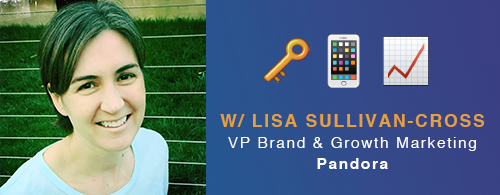When we look at the App Store charts, there are a few apps that constantly occupy some of the coveted top positions. Pandora is unquestionably one of them. While it’s not only a key player in the app store, Pandora is a powerhouse in driving growth, at scale. We had the chance to chat with the company’s VP of Growth, Lisa Sullivan-Cross (@sullycross), and discussed her strategies to turn app users, into paying customers.

We can categorize these tactics into two different levers: product strategies (inside the app) and marketing channels (outside of the app). In the first part of our article series, we’ll take a closer look at the product side and continue with the marketing channels in our next article.
Anything in quotes below is attributed to Lisa Sullivan-Cross.
Building Product for Long-Term Customers
Map Out ROI Metrics
Growing app revenue requires an analytics structure that is tailored to your business and product. Pandora focuses on two different revenue models: advertising and subscription. This sets the tone for their metrics framework and performance tracking:
“Ultimately, we look at revenue and ROI metrics for all of our marketing programs. It takes into consideration ROI from advertising and subscriptions. On our ad-supported side, we optimize marketing using cost per incremental listener and cost per incremental hour. That combination takes into account the quality of listeners we acquire or re-engage, and tells us if the person is valuable for our business. We follow cohorts of users from each acquisition channels to determine how valuable they are over time. That allows us to explore the propensity of users to subscribe by different acquisition channels.”
User Actions Inform Subscription Timeline
Lisa points out that it’s key to identify which user actions impact subscriptions. “We look at all of our common usage patterns such as giving a thumbs-up or thumbs-down, skipping a song, how many stations are users adding and how engaged are they on a station and map that to subscription conversion. This all gives us a good handle on which usage behaviors predict propensity to subscribe.“
It’s All About the Users
App personalization is a popular topic among the growth crowd and it’s something that Pandora has leveraged for many years now. We also heard from John Egan at Pinterest, on how beneficial it can be to create a customized user experience and how to adjust content feeds to users interests.
“If people give us inputs such as a thumbs-up or thumbs-down, it creates a better station experience for them: Your station changes if you like or don’t like a song. We do that through our algorithms, machine learning, and constant testing. In addition, we have musicologists that evaluate each song before it’s ingested into the Pandora system. They look at over 400 different attributes and rate each song on how it scores against these attributes. So if people interact with the app, it creates a better station for them, and better stations lead to higher retention rates.”
Customize Subscription Offers
Similar to other music services, Pandora offers a subscription plan on a monthly basis. However, their offer also includes a day pass, which is rather uncommon for subscription services. “We found out that some users didn’t want a monthly subscription because they didn’t mind the ads most of the time. But maybe they are having a party at their house, and don’t want the music to be interrupted by ads. People who purchased a day pass and had a taste of an ad-free experience were more receptive to an upsell message of subscribing to the monthly service.” This shows how beneficial it can be to test different subscription plans and not blindly follow industry standards. For Pandora, this was a great lever to drive new subscriptions and at the same time, they gave users more flexibility. Win-Win.
Utilizing In-App Communication Channels
In-app communication can significantly help you to drive growth: You can use it to educate your users, guide them to try your brand-new app feature or simply keep your users in the loop with your latest promotions. Pandora, focus on three different conversation types: “We have in-product messaging interstitials, a feed section, and house-ads. The interstitials educate people around how to use thumbs and other product features as well as upsell to subscription—we serve upsell interstitials only to listeners we believe are interested in subscribing by using a likelihood to subscribe model built by our data science team.” The feed is used to suggest new stations that users might like and house-ads are placed instead of 3rd party ads to urge people to subscribe. While your in-app communication strategy will probably look different, Pandora’s approach is a good example of a messaging that targets all key steps in a user’s lifecycle: First, they educate users to drive activation, then suggest new content to increase engagement and finally broadcast their house-ads to convert users into subscribers.
What do you think about Lisa’s tips? Part two with Lisa will focus on marketing channels. Be sure to Tweet us @flurrymobile, using #KeysToMobileGrowth with any burning questions you might have!